Abstract
The resistance to bacteria was studied at the site of delayed footpad reaction in mice immunized with Listeria monocytogenes. When a challenge injection of listeria was given into the footpad of immune mice, no enhancement of bacterial elimination was observed before the generation of delayed footpad reactivity. After the generation of delayed reactivity, an enhanced elimination of listeria or Salmonella typhimurium was observed only at the site of strongly positive delayed footpad reaction elicited with listerial antigen. Such an enhancement in bacterial elimination was also found at the site of delayed footpad reaction induced by immunization with heterologous erythrocytes. Both delayed footpad reaction and local resistance could be transferred locally by immune spleen cells in a dose-dependent fashion, but were completely abrogated when recipient mice were treated with carrageenan or whole-body X irradiation. Macrophage accumulation was an important factor in the expression of resistance at the reaction site. These results suggest that the delayed footpad reaction contributes to host defense by enhancing the local resistance to bacteria.
Full text
PDF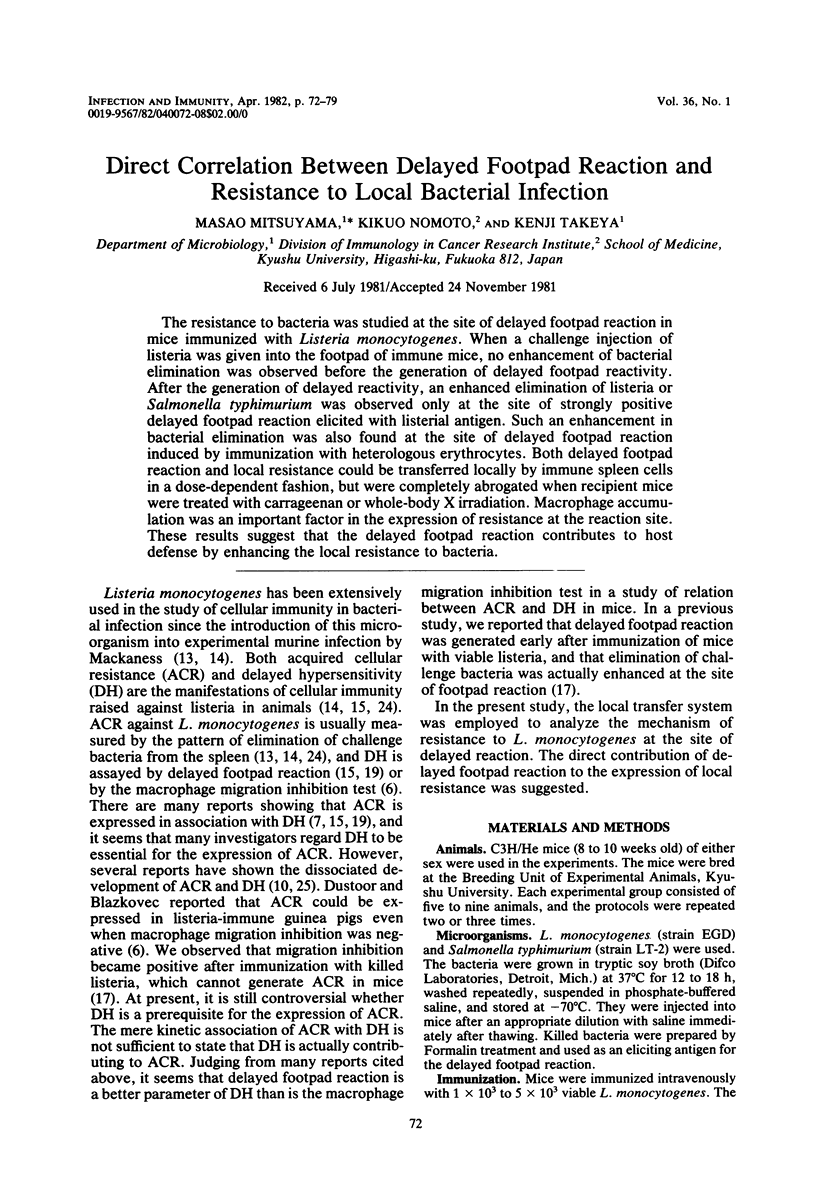
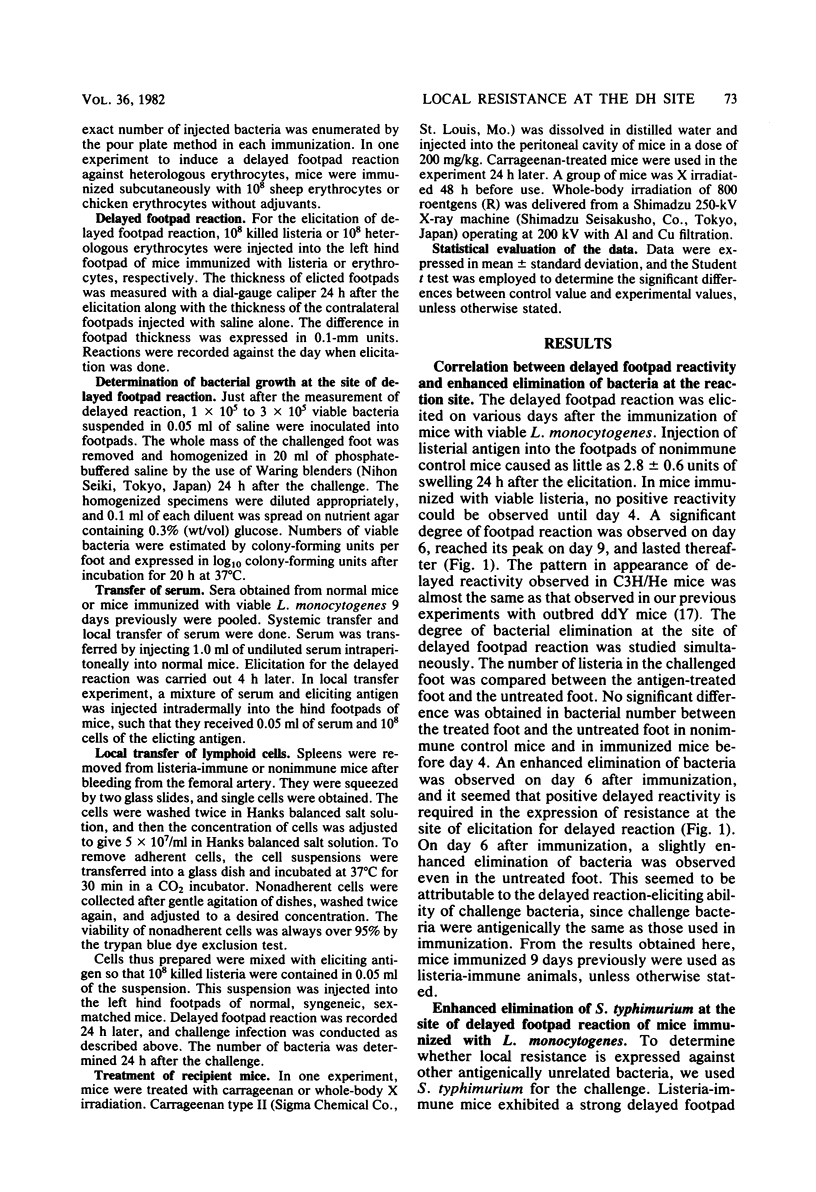
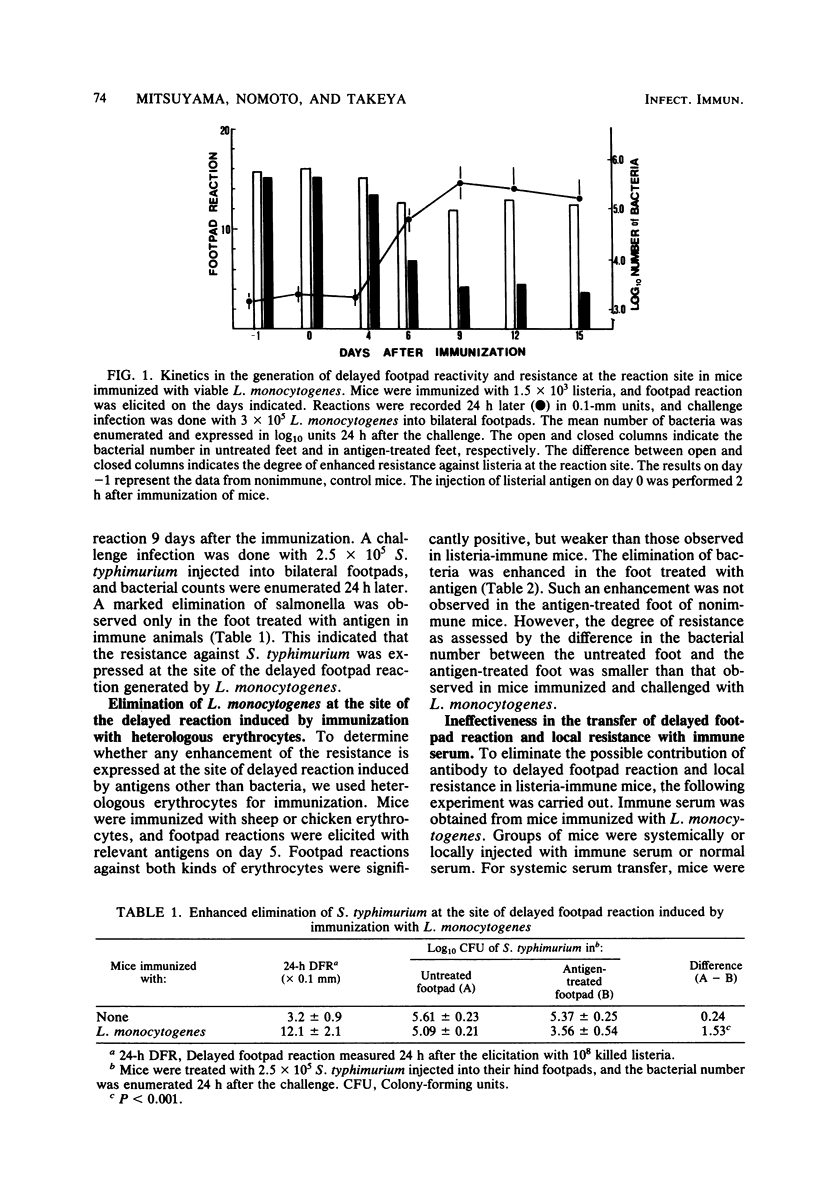


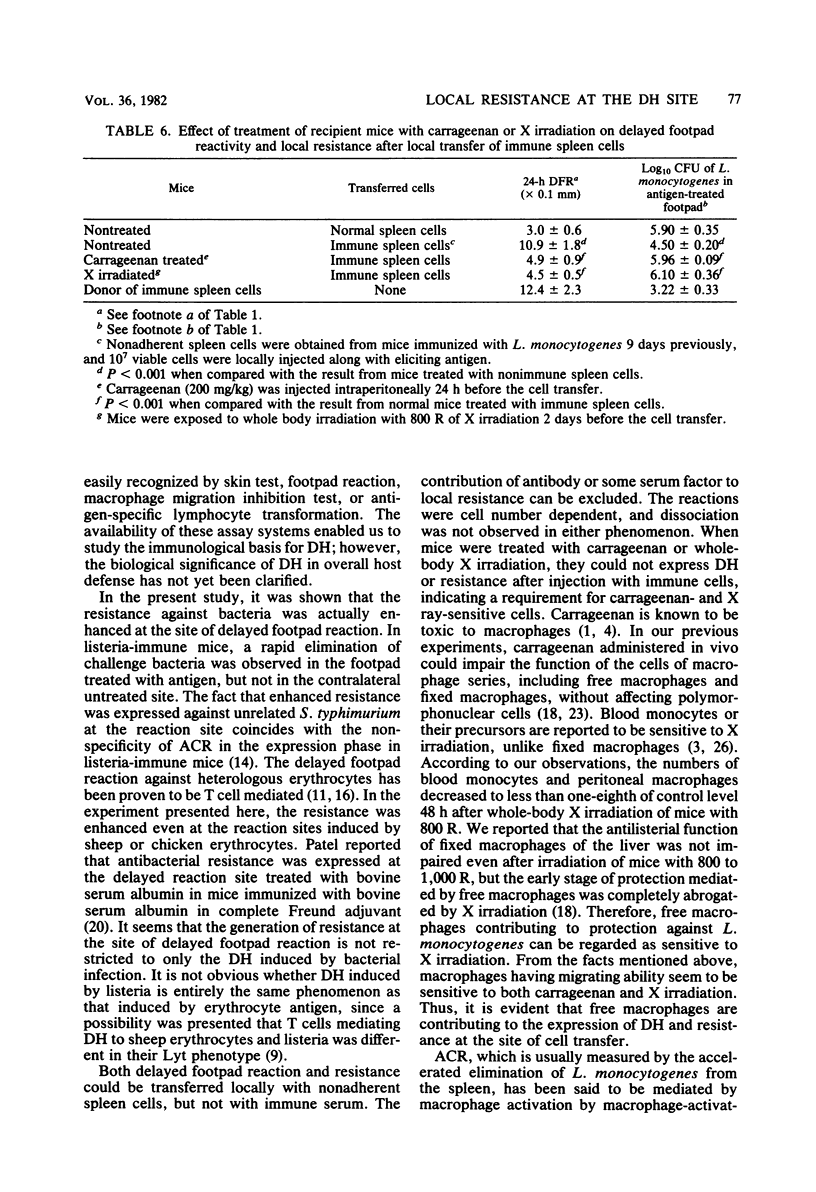
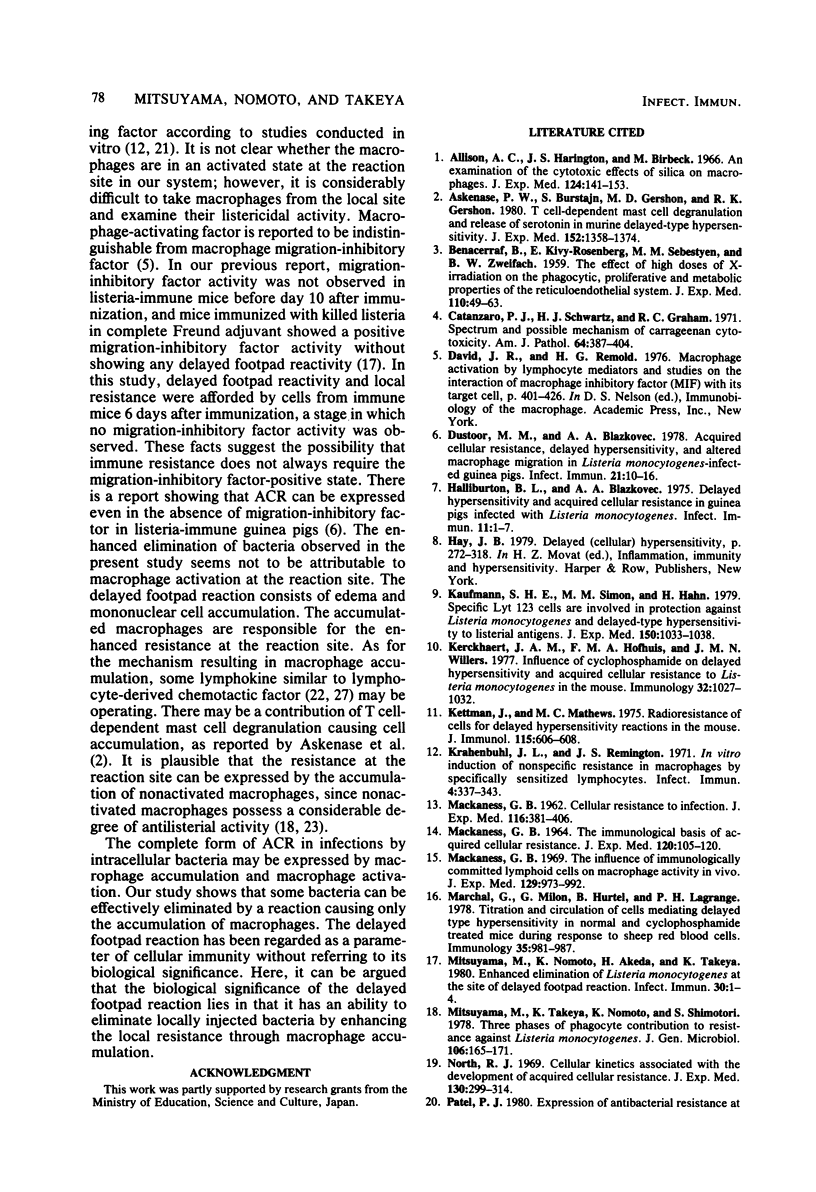
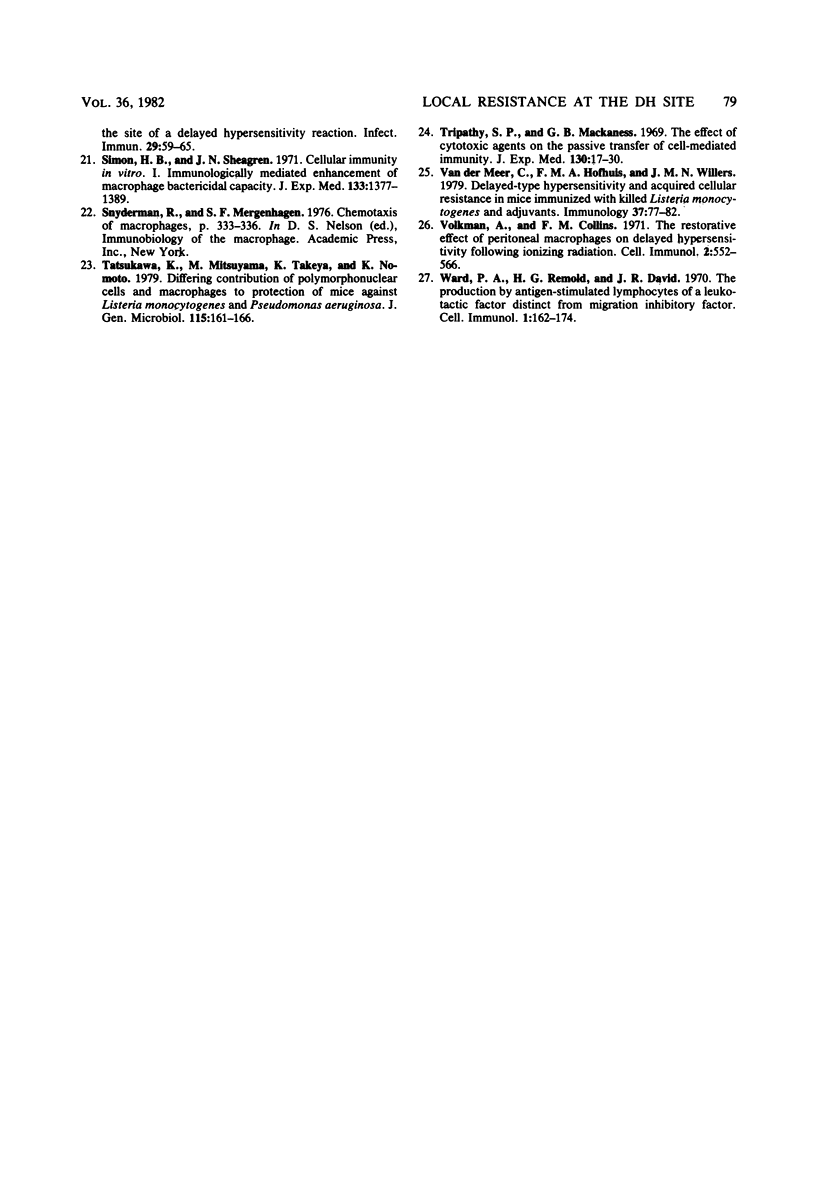
Selected References
These references are in PubMed. This may not be the complete list of references from this article.
- Allison A. C., Harington J. S., Birbeck M. An examination of the cytotoxic effects of silica on macrophages. J Exp Med. 1966 Aug 1;124(2):141–154. doi: 10.1084/jem.124.2.141. [DOI] [PMC free article] [PubMed] [Google Scholar]
- Askenase P. W., Bursztajn S., Gershon M. D., Gershon R. K. T cell-dependent mast cell degranulation and release of serotonin in murine delayed-type hypersensitivity. J Exp Med. 1980 Nov 1;152(5):1358–1374. doi: 10.1084/jem.152.5.1358. [DOI] [PMC free article] [PubMed] [Google Scholar]
- BENACERRAF B., KIVY-ROSENBERG E., SEBESTYEN M. M., ZWEIFACH B. W. The effect of high doses of x-irradiation on the phagocytic, proliferative, and metabolic properties of the reticulo-endothelial system. J Exp Med. 1959 Jul 1;110(1):49–64. doi: 10.1084/jem.110.1.49. [DOI] [PMC free article] [PubMed] [Google Scholar]
- Catanzaro P. J., Schwartz H. J., Graham R. C., Jr Spectrum and possible mechanism of carrageenan cytotoxicity. Am J Pathol. 1971 Aug;64(2):387–404. [PMC free article] [PubMed] [Google Scholar]
- Dustoor M. M., Blazkovec A. A. Acquired cellular resistance, delayed hypersensitivity, and altered macrophage migration in Listeria monocytogenes-infected guinea pigs. Infect Immun. 1978 Jul;21(1):10–16. doi: 10.1128/iai.21.1.10-16.1978. [DOI] [PMC free article] [PubMed] [Google Scholar]
- Halliburton B. L., Blazkovec A. A. Delayed hypersensitivity and acquired cellular resistance in guinea pigs infected with Listeria monocytogenes. Infect Immun. 1975 Jan;11(1):1–7. doi: 10.1128/iai.11.1.1-7.1975. [DOI] [PMC free article] [PubMed] [Google Scholar]
- Kaufmann S. H., Simon M. M., Hahn H. Specific Lyt 123 cells are involved in protection against Listeria monocytogenes and in delayed-type hypersensitivity to listerial antigens. J Exp Med. 1979 Oct 1;150(4):1033–1038. doi: 10.1084/jem.150.4.1033. [DOI] [PMC free article] [PubMed] [Google Scholar]
- Kerckhaert J. A., Hofhuis F. M., Willers J. M. Influence of cyclophosphamide on delayed hypersensitivity and acquired cellular resistance to Listeria monocytogenes in the mouse. Immunology. 1977 Jun;32(6):1027–1032. [PMC free article] [PubMed] [Google Scholar]
- Kettman J., Mathews M. C. Radioresistance of cells responsible for delayed hypersensitivity reactions in the mouse. J Immunol. 1975 Aug;115(2):606–608. [PubMed] [Google Scholar]
- Krahenbuhl J. L., Remington J. S. In vitro induction of nonspecific resistance in macrophages by specifically sensitized lymphocytes. Infect Immun. 1971 Oct;4(4):337–343. doi: 10.1128/iai.4.4.337-343.1971. [DOI] [PMC free article] [PubMed] [Google Scholar]
- MACKANESS G. B. Cellular resistance to infection. J Exp Med. 1962 Sep 1;116:381–406. doi: 10.1084/jem.116.3.381. [DOI] [PMC free article] [PubMed] [Google Scholar]
- MACKANESS G. B. THE IMMUNOLOGICAL BASIS OF ACQUIRED CELLULAR RESISTANCE. J Exp Med. 1964 Jul 1;120:105–120. doi: 10.1084/jem.120.1.105. [DOI] [PMC free article] [PubMed] [Google Scholar]
- Mackaness G. B. The influence of immunologically committed lymphoid cells on macrophage activity in vivo. J Exp Med. 1969 May 1;129(5):973–992. doi: 10.1084/jem.129.5.973. [DOI] [PMC free article] [PubMed] [Google Scholar]
- Marchal G., Milon G., Hurtrel B., Lagrance P. H. Titration and circulation of cells mediating delayed type hypersensitivity in normal and cyclophosphamide treated mice during response to sheep red blood cells. Immunology. 1978 Dec;35(6):981–987. [PMC free article] [PubMed] [Google Scholar]
- Mitsuyama M., Nomoto K., Akeda H., Takeya K. Enhanced elimination of Listeria monocytogenes at the site of delayed footpad reaction. Infect Immun. 1980 Oct;30(1):1–4. doi: 10.1128/iai.30.1.1-4.1980. [DOI] [PMC free article] [PubMed] [Google Scholar]
- Mitsuyama M., Takeya K., Nomoto K., Shimotori S. Three phases of phagocyte contribution to resistance against Listeria monocytogenes. J Gen Microbiol. 1978 May;106(1):165–171. doi: 10.1099/00221287-106-1-165. [DOI] [PubMed] [Google Scholar]
- North R. J. Cellular kinetics associated with the development of acquired cellular resistance. J Exp Med. 1969 Aug 1;130(2):299–314. doi: 10.1084/jem.130.2.299. [DOI] [PMC free article] [PubMed] [Google Scholar]
- Patel P. J. Expression of antibacterial resistance at the site of a delayed hypersensitivity reaction. Infect Immun. 1980 Jul;29(1):59–65. doi: 10.1128/iai.29.1.59-65.1980. [DOI] [PMC free article] [PubMed] [Google Scholar]
- Simon H. B., Sheagren J. N. Cellular immunity in vitro. I. Immunologically mediated enhancement of macrophage bactericidal capacity. J Exp Med. 1971 Jun 1;133(6):1377–1389. doi: 10.1084/jem.133.6.1377. [DOI] [PMC free article] [PubMed] [Google Scholar]
- Tatsukawa K., Mitsuyama M., Takeya K., Nomoto K. Differing contribution of polymorphonuclear cells and macrophages to protection of mice against Listeria monocytogenes and Pseudomonas aeruginosa. J Gen Microbiol. 1979 Nov;115(1):161–166. doi: 10.1099/00221287-115-1-161. [DOI] [PubMed] [Google Scholar]
- Tripathy S. P., Mackaness G. B. The effect of cytotoxic agents on the passive transfer of cell-mediated immunity. J Exp Med. 1969 Jul 1;130(1):17–30. doi: 10.1084/jem.130.1.17. [DOI] [PMC free article] [PubMed] [Google Scholar]
- Van Der Meer C., Hofhuis F. M., Willers J. M. Delayed-type hypersensitivity and acquired cellular resistance in mice immunized with killed Listeria monocytogenes and adjuvants. Immunology. 1979 May;37(1):77–82. [PMC free article] [PubMed] [Google Scholar]
- Volkman A., Collins F. M. The restorative effect of peritoneal macrophages on delayed hypersensitivity following ionizing radiation. Cell Immunol. 1971 Dec;2(6):552–566. doi: 10.1016/0008-8749(71)90004-9. [DOI] [PubMed] [Google Scholar]
- Ward P. A., Remold H. G., David J. R. The production by antigen-stimulated lymphocytes of a leukotactic factor distinct from migration inhibitory factor. Cell Immunol. 1970 Jul;1(2):162–174. doi: 10.1016/0008-8749(70)90003-1. [DOI] [PubMed] [Google Scholar]


